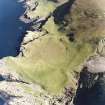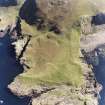Pricing Change
New pricing for orders of material from this site will come into place shortly. Charges for supply of digital images, digitisation on demand, prints and licensing will be altered.
Canna, Rubha Langanes
Building (Period Unassigned), Cairnfield (Period Unassigned), Hut(S) (Period Unassigned), Mound(S) (Period Unassigned)
Site Name Canna, Rubha Langanes
Classification Building (Period Unassigned), Cairnfield (Period Unassigned), Hut(S) (Period Unassigned), Mound(S) (Period Unassigned)
Canmore ID 10722
Site Number NG20NW 16
NGR NG 2429 0655
NGR Description Centred NG 2429 0655
Datum OSGB36 - NGR
Permalink http://canmore.org.uk/site/10722
- Council Highland
- Parish Small Isles
- Former Region Highland
- Former District Lochaber
- Former County Inverness-shire
NG20NW 16 centred 2429 0655
Centred NG 2423 0655. Remains of two bothies with contemporary walls.
Visited by OS 27 May 1972.
(Formerly recorded as NMRS NG20NW 21 at cited location NG 24 06). South of NG20NW 3 are a group of mounds not mentioned in the Inventory. To reach them, climb up from NG20NW 3 and then down on to a broad grass slope which runs seawards and then falls quickly away with clefts and cracks under which the sea washes in and out. 'On this slope there was a whole cluster of Viking graves which, as far as one can judge, have never been disturbed. Only down at the edge is one which is open. The mounds are round but one is long and narrow...'. (Visited 1943).
A Sommerfelt 1984.
Structures on Sanday, previously identified as 'Viking graves' are now recognised as probable shieling-huts or kelp drying kilns.
L Alcock 1983.
(Location changed to centred NG 2429 0655 and classification to building, huts, mounds and field clearance cairns).
A group of four possible huts, a rectangular building and two oval mounds occupies a grassy strip of land overlooking the sea at Rubha Langanes. Most of the group lie to either side of a modern fence, but one mound and a hut are situated some 60m to the W (NG 2423 0656). This mound contains a considerable quantity of stones and measures 7.7m from NW to SE by 4m; it is overlain by a stretch of ruinous stone wall. The hut is set on top of the mound and also appears to be later than the wall. The remaining three huts are all subrectangular and range in size from 1.7m by 1m to 4m by 2.5m within stony banks. The rectangular building, and a second mound, lie on the W side of the fence (NG 2430 0655), and the building survives as a mass of tumbled stones measuring 8m from E to W by 4.5m overall. Its interior has been terraced into the slope on the S side. A few small heaps of cleared stones can be seen in the immediate vicinity.
(Canna 177-80, 1001-3).
Visited by RCAHMS (SPH, ARG), 10 March 1996.
The structures (classified as mounds, shieling-huts and kelp-working sites) formerly described under NMRS NG20NW 21 are included in NG20NW 16.
Information from RCAHMS (ARG), 13 December 1996.
Field Visit (27 May 1972)
Centred NG 2423 0655. Remains of two bothies with contemporary walls.
Visited by OS 27 May 1972.
Note (13 December 1996)
The structures (classified as mounds, shieling-huts and kelp-working sites) formerly described under NMRS NG20NW 21 are included in NG20NW 16.
Information from RCAHMS (ARG), 13 December 1996.
Field Visit (10 March 1996)
(Location changed to centred NG 2429 0655 and classification to building, huts, mounds and field clearance cairns).
A group of four possible huts, a rectangular building and two oval mounds occupies a grassy strip of land overlooking the sea at Rubha Langanes. Most of the group lie to either side of a modern fence, but one mound and a hut are situated some 60m to the W (NG 2423 0656). This mound contains a considerable quantity of stones and measures 7.7m from NW to SE by 4m; it is overlain by a stretch of ruinous stone wall. The hut is set on top of the mound and also appears to be later than the wall. The remaining three huts are all subrectangular and range in size from 1.7m by 1m to 4m by 2.5m within stony banks. The rectangular building, and a second mound, lie on the W side of the fence (NG 2430 0655), and the building survives as a mass of tumbled stones measuring 8m from E to W by 4.5m overall. Its interior has been terraced into the slope on the S side. A few small heaps of cleared stones can be seen in the immediate vicinity.
(Canna 177-80, 1001-3).
Visited by RCAHMS (SPH, ARG), 10 March 1996.
















